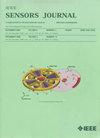Human Sleep Posture Recognition Exploiting Spatial Morphology and Local Micro-Doppler Characteristics Using MIMO Radar
IF 4.3
2区 综合性期刊
Q1 ENGINEERING, ELECTRICAL & ELECTRONIC
引用次数: 0
Abstract
Radar sleep posture recognition has received much attention due to its advantages, such as privacy preservation and freedom from quilt occlusion. However, radar echo signals are highly sensitive to different humans, which leads to poor generalization ability. To address this problem, we propose a human sleep posture recognition method exploiting spatial morphology and local micro-Doppler characteristics using multiple-input multiple-output (MIMO) radar. We first perform multidimensional imaging of human targets. Then, we extract the spatial morphology features of human sleep posture and local micro-Doppler features of human sleep life activities and utilize the Bagged Trees classifier to complete the classification of left lateral, right lateral, and nonlateral. For the nonlateral posture, we further extract new feature sequences from multidimensional imaging and combine them with a long and short-term memory (LSTM) network to complete the classification of supine and prone posture. Experimental results show that the proposed method achieves an average accuracy of 97.6% for recognizing the four sleep postures, has good reliability across individuals, and performs efficiently in most types of beds with single human at different sleeping positions. Finally, we have deployed the proposed method in a designed real-time system, validating its low computation complexity and the feasibility of edge applications.利用MIMO雷达的空间形态和局部微多普勒特征进行人体睡眠姿势识别
雷达睡眠姿势识别因其具有保护隐私、不受被子遮挡等优点而备受关注。但雷达回波信号对不同人的敏感度较高,导致其泛化能力较差。为了解决这个问题,我们提出了一种利用多输入多输出(MIMO)雷达的空间形态学和局部微多普勒特征的人体睡眠姿势识别方法。我们首先对人体目标进行多维成像。然后,提取人体睡眠姿势的空间形态特征和人体睡眠生命活动的局部微多普勒特征,利用Bagged Trees分类器完成左侧、右侧和非侧位的分类。对于非侧卧姿势,我们进一步从多维影像中提取新的特征序列,并将其与长短期记忆(LSTM)网络相结合,完成对仰卧和俯卧姿势的分类。实验结果表明,该方法对四种睡姿的识别平均准确率为97.6%,具有良好的跨个体可靠性,在大多数单人睡姿的床型中均能有效识别。最后,我们在设计的实时系统中部署了该方法,验证了其低计算复杂度和边缘应用的可行性。
本文章由计算机程序翻译,如有差异,请以英文原文为准。
求助全文
约1分钟内获得全文
求助全文
来源期刊

IEEE Sensors Journal
工程技术-工程:电子与电气
CiteScore
7.70
自引率
14.00%
发文量
2058
审稿时长
5.2 months
期刊介绍:
The fields of interest of the IEEE Sensors Journal are the theory, design , fabrication, manufacturing and applications of devices for sensing and transducing physical, chemical and biological phenomena, with emphasis on the electronics and physics aspect of sensors and integrated sensors-actuators. IEEE Sensors Journal deals with the following:
-Sensor Phenomenology, Modelling, and Evaluation
-Sensor Materials, Processing, and Fabrication
-Chemical and Gas Sensors
-Microfluidics and Biosensors
-Optical Sensors
-Physical Sensors: Temperature, Mechanical, Magnetic, and others
-Acoustic and Ultrasonic Sensors
-Sensor Packaging
-Sensor Networks
-Sensor Applications
-Sensor Systems: Signals, Processing, and Interfaces
-Actuators and Sensor Power Systems
-Sensor Signal Processing for high precision and stability (amplification, filtering, linearization, modulation/demodulation) and under harsh conditions (EMC, radiation, humidity, temperature); energy consumption/harvesting
-Sensor Data Processing (soft computing with sensor data, e.g., pattern recognition, machine learning, evolutionary computation; sensor data fusion, processing of wave e.g., electromagnetic and acoustic; and non-wave, e.g., chemical, gravity, particle, thermal, radiative and non-radiative sensor data, detection, estimation and classification based on sensor data)
-Sensors in Industrial Practice
 求助内容:
求助内容: 应助结果提醒方式:
应助结果提醒方式:


